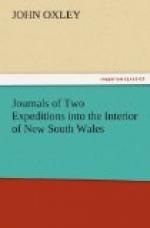the expedition as a volunteer; that to the north-north-west,
Mount Forster, after Lieutenant Forster, of the Navy;
and the lofty range before mentioned to the eastward
was distinguished by the name of Arbuthnot’s
Range, after the Right Hon. C. Arbuthnot, of His Majesty’s
Treasury. The two first mentioned hills are entirely
of granite, from one and a half to two miles long,
by half a mile to one mile wide: their formation
must be considered a most singular geological phenomenon,
detached as they are by an immense space from all mountainous
ranges, and rising from the midst of a soft alluvial
soil. Small pieces of granite were in several
places thrown into heaps, as if by human means; and
their whole surfaces were covered with similar pieces,
detached from the solid mass to which they had once
belonged. If I might hazard a conjecture, I should
attribute to them a volcanic origin: I think,
on examination, their constituent parts will be found
to have undergone the action of fire, by which they
have been fused together. To those conversant
in the structure of the earth, and with the means used
by nature to accomplish her purposes, these singular
hills may offer a subject for curious inquiry.
The natives appear numerous in these regions of apparent
desolation: we fell in with several parties in
the course of the day, in the whole probably not less
than forty, and many fires were seen to the north.
Being a mile or two ahead of our party in a thick
brush, I came suddenly upon three men; two ran off
with the greatest speed; the third, who was older
and a little lame, first threw his firestick at me,
and next (seeing me still advance) a waddie, but with
such agitation, that though not more than a dozen paces
distant, he missed both me and my horse. I returned
to my party, and in company with them surprised the
native camp; we found there eight women and twelve
children, just on the point of departing with their
infants in their cloaks on their backs: on seeing
us, they seized each other by the hand, formed a circle,
and threw themselves on the ground, with their heads
and faces covered. Unwilling to add to their evident
terror, we only remained a few minutes, during which
time the children frequently peeped at us from beneath
their clothes; indeed, they seemed more surprised
than alarmed: the mothers kept uttering a low
and mournful cry, as if entreating mercy. In
the camp were several spears, or rather lances, as
they were much too ponderous to be thrown by the arm;
these were jagged: there were also some elamongs
(shields), clubs, chisels, and several workbags filled
with every thing necessary for the toilet of a native
belle; namely, paint and feathers, necklaces of teeth,
and nets for the head, with thread formed of the sinews
of the opossum’s tail for making their cloaks.
The men belonging to the camp were heard shouting at
no great distance: their affection for their
families was not, however, sufficiently powerful to
induce them to attempt their rescue from the hands




